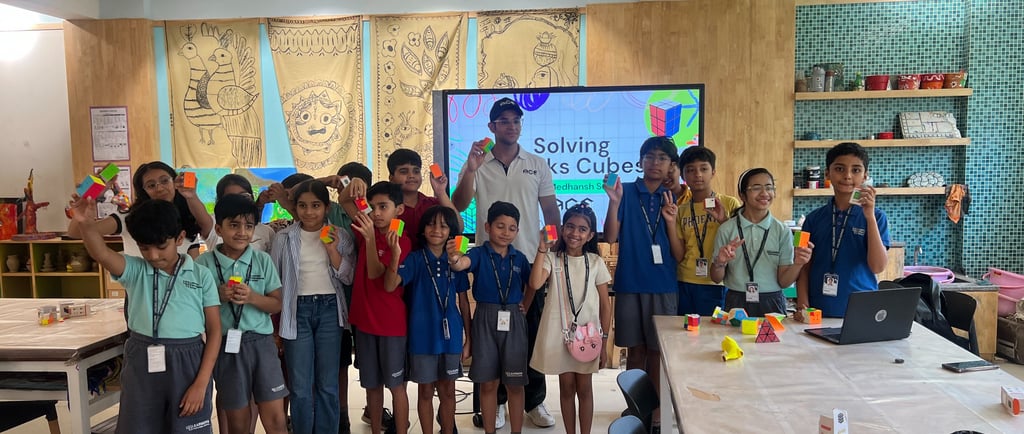I Taught 600+ Kids the Rubik’s Cube — Here’s What It Taught Me About Patience, People, and Teaching
Teaching the Rubik’s Cube to over 600 kids changed the way I see learning, patience, and leadership. Here's what this journey taught me about people, purpose, and the art of teaching.
Medhansh Seth
6/19/20253 min read


I still remember the first time I taught someone how to solve the Rubik’s Cube. It wasn’t in a big workshop hall or on a Zoom call. It was at my dining table, the same one where I used to eat Maggi after school. I had just turned 11, and my cousin had come over, curious about the colorful cube I carried around like a prized possession. He asked, “Can you teach me?” I smiled, not knowing that this small moment would one day grow into a mission where I’d end up teaching over 600 kids across India.
It wasn’t always glamorous. There were no microphones, no spotlight, no startup dreams in the beginning — just a kid who had spent countless hours fumbling with a cube until it clicked. When I started AceCubing, I wasn’t thinking about scaling or branding. I was just excited that I had cracked something cool — and even more excited to share it.
But teaching 600+ kids? That wasn’t just about cubing. It was a crash course in patience, empathy, and leadership.
Lesson 1: Patience Isn’t Just Waiting — It’s Trusting the Process
When you teach a kid the Rubik’s Cube, the first thing you learn is that everyone thinks differently. Some get the white cross instantly. Others take 40 minutes to remember just one algorithm. Early on, I used to get frustrated. I’d think, “Why don’t they get it? It’s so simple!” But I slowly realized — it’s only simple because I’ve done it a thousand times. For them, it’s a new language.
I began developing a habit: after every session, I’d take 15 minutes to reflect. What worked? What confused them? Where did I speak too fast? These reflections became my secret weapon. They helped me slow down and see teaching as a two-way street — not a performance, but a partnership. I consulted teachers and made the critique my teaching style.
Lesson 2: Kids Don’t Just Learn from You — They Teach You, Too
When you’re in front of a classroom, or even on a Zoom screen with 15 kids all unmuting at the same time, it’s easy to think you’re the one in control. But honestly? I’ve learned more from my students than they probably did from me.
They taught me how to laugh at mistakes. How to explain the same thing 5 different ways. How to keep energy up even when the Wi-Fi’s down. I had gotten so focused on being “efficient” that I’d forgotten how powerful it is to be human while teaching.
Lesson 3: Leadership Isn’t Loud — It’s Being There, Consistently
When people think of “leaders,” they think of speeches, big decisions, fancy titles. But real leadership, I learned, is often quiet. It’s in being the most consistent person in the room. It’s in showing up, even when no one claps.
The Human Side of Teaching
What people don’t often talk about is the emotional investment of teaching. You remember each child’s progress, their quirks, their stories. You remember the boy who used to stammer when reading out algorithms but grew more confident with each solve. You remember the shy girl who finally raised her hand during a group session. You remember parents thanking you not for teaching a cube — but for building their child’s focus, confidence, and self-esteem.
This journey wasn’t just about the Rubik’s Cube. It was about using the cube as a medium for connection. A bridge between curiosity and confidence. Between a confused kid and a proud smile.
Closing Thoughts: Why I’ll Never Stop Teaching
Today, AceCubing has grown into more than just a passion project. We’ve done workshops across schools, collaborated with organizations, and even built courses that reach kids beyond city borders. But no matter how big it gets, I remind myself: it all began with one cube, one child, one conversation.
And while I may have taught over 600 kids how to solve the Rubik’s Cube, what I really did was spend hundreds of hours listening, learning, guiding, and growing — right alongside them.
Teaching taught me how to lead with empathy, how to trust slow progress, and how to show up even when no one’s watching.
So the next time someone asks me what cubing taught me, I won’t just say algorithms.
I’ll say: It taught me people.

